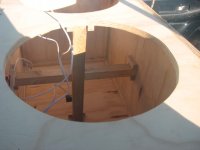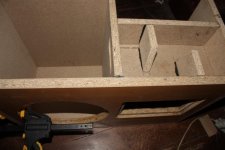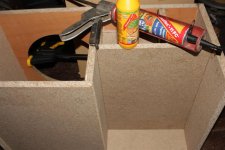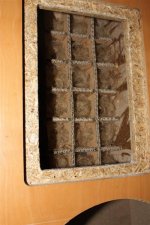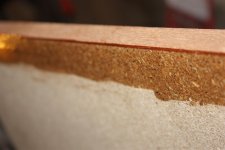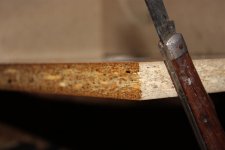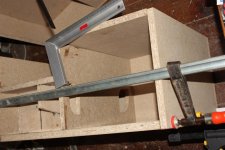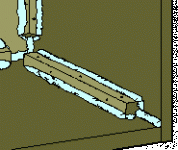I guess I was thinking more about machining the stuff!
Don
that's something you shouldn't be thinking about 🙄
makes for great packing crates, or as Don noted, sheathing - but don't rely on fasteners applied into end grain, even if predrilled
when using screws, its important to fill screw holes with glue
or instead remove screws later, and replace with wood plugs, works fine too
GM, I dont know what you mean by screw blocks ?
or instead remove screws later, and replace with wood plugs, works fine too
GM, I dont know what you mean by screw blocks ?
Center image: http://www.lansingheritage.org/images/altec/plans/1974-enc-design/page18.jpg
The screws will carry enough glue into the holes to make for a strong, worry free joint.
GM
The screws will carry enough glue into the holes to make for a strong, worry free joint.
GM
?? The vast majority of cabs I've built were made from void free marine grade and they all had screw blocks holding them together, though I didn't use as many screws as in the picture, just one every 6-8".
GM
GM
Hi Don,
The resilient coating actually works very well. The high pitched "tock" sound lost the high frequency components after coating the wood. Our first use was on the HDF boxes. Those darn things can be machined. In fact, it's best that you think that way when building them. As for end "grain" screws - no problems. Particle board does not have a grain, so the only thing to worry about is splitting. Pilot holes remove that thread, and it's good to over-drill the hole. That allows the excess glue to go somewhere. There may even be some compressed air (a very, tiny little bit).
We began using dowels and later biscuits for bonding and holding things together. Once the glue has cured, any hardware is completely superfluous. You're further ahead to remove it if the cabinet will deal with high SPL. For normal home speakers, your only concern is having the filler fall out later. The one large plus screws do have is that they align and apply pressure to the joint until the glue sets and cures. With dowels and biscuits, you need to apply pressure evenly with straps or bar clamps.
I only use cleats or blocks in shelving or drawers. Speaker boxes don't need them any more unless you are building a Karlson or horn types. I'm sure that other fancy enclosures could use them as well.
-Chris
The resilient coating actually works very well. The high pitched "tock" sound lost the high frequency components after coating the wood. Our first use was on the HDF boxes. Those darn things can be machined. In fact, it's best that you think that way when building them. As for end "grain" screws - no problems. Particle board does not have a grain, so the only thing to worry about is splitting. Pilot holes remove that thread, and it's good to over-drill the hole. That allows the excess glue to go somewhere. There may even be some compressed air (a very, tiny little bit).
We began using dowels and later biscuits for bonding and holding things together. Once the glue has cured, any hardware is completely superfluous. You're further ahead to remove it if the cabinet will deal with high SPL. For normal home speakers, your only concern is having the filler fall out later. The one large plus screws do have is that they align and apply pressure to the joint until the glue sets and cures. With dowels and biscuits, you need to apply pressure evenly with straps or bar clamps.
I only use cleats or blocks in shelving or drawers. Speaker boxes don't need them any more unless you are building a Karlson or horn types. I'm sure that other fancy enclosures could use them as well.
-Chris
I wasn't dissing the screw block idea, though it's not always practical, just the idea of using OSB!
Don
Don
ah, yes
I like screw blocks too
but these days I mount them with flexible and strongly sticking silicone, and no screws
but I mount them after assembling
I consider it like corner bracing, just stick it on, let it dry, and done
I like screw blocks too
but these days I mount them with flexible and strongly sticking silicone, and no screws
but I mount them after assembling
I consider it like corner bracing, just stick it on, let it dry, and done
Hi Don,
I just can't ever imagine myself using OSB, but some people must love it. To each his own.
I once had a customer who used flexible material (no idea what it was) to make perfect spherical enclosures. He swore it would be superior to any other box. My thought on the matter were simple. Talk about one heck of a single resonant mode! That and being flexible never made sense to me. Perhaps in a sphere, flexible is good? I don't know, it simply doesn't make any sense to me. A guy I worked with paid this guy to make 10" boxes for his car (1977 Malibu). They went into the rear parcel shelf.
It looked like a large <unprintable words> frog was coming up behind him. Sounded horrible on top of that.
-Chris
I just can't ever imagine myself using OSB, but some people must love it. To each his own.
I once had a customer who used flexible material (no idea what it was) to make perfect spherical enclosures. He swore it would be superior to any other box. My thought on the matter were simple. Talk about one heck of a single resonant mode! That and being flexible never made sense to me. Perhaps in a sphere, flexible is good? I don't know, it simply doesn't make any sense to me. A guy I worked with paid this guy to make 10" boxes for his car (1977 Malibu). They went into the rear parcel shelf.
It looked like a large <unprintable words> frog was coming up behind him. Sounded horrible on top of that.
-Chris
cleats
Works great if you only have a few bar clamps like me
Thanks, I knew there was another word for them as in cleat stair construction, but couldn't remember or find it in a quick search.
Me too, apparently I missed the memo about a DIYer never having too many clamps.
GM
I wasn't dissing the screw block idea, though it's not always practical, just the idea of using OSB!
Don
Ah! Yeah, I only did it once out of curiosity when it first came out. They worked well with ~1.6 Qts 'FR' drivers and looked kind of neat with a semi-transparent stain, but hated cutting, drilling it.
GM
one major important thing, be it expencive plywood or cheap particle chipboard, all cuts needs to be 100% straight and perfectly angled, or it will suck big time
and still a good idea to check angle when assembling
managed to assemble bottoms, and shoot a few pictures showing soaked joints
I keep applying glue to both joining parts, layer by layer, multiple times until its fully soaked
and still a good idea to check angle when assembling
managed to assemble bottoms, and shoot a few pictures showing soaked joints
I keep applying glue to both joining parts, layer by layer, multiple times until its fully soaked
Attachments
There is simply no reason why the DIYer's out there shouldn't seal the inside of their boxes. It is not that difficult and really only represents a little more money and another step or two. You can tape out the joint areas before painting or spraying. Too easy.
I'm trying to fill the (quite wide) gaps in my knowledge: Should I silicon all the edges in the box or also completely cover the insides of the box with something?
About bracing, should battens be used to secure the edges of the box?
?? The vast majority of cabs I've built were made from void free marine grade and they all had screw blocks holding them together, though I didn't use as many screws as in the picture, just one every 6-8".
GM
Nice and simple... one does not need so many clamps!
-Zia
My bad, it seems that battens is what ppl here refered as cleats. Anyway the pic below is what I ment.About bracing, should battens be used to secure the edges of the box?
Attachments
- Status
- Not open for further replies.
- Home
- Loudspeakers
- Full Range
- Boxes or Not
